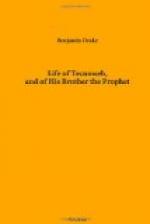About the period of Winnemac’s visit, an Indian belonging to the Iowa tribe, told general Harrison, that two years before, a British agent visited the Prophet, and delivered a message to him. The object was to induce the Prophet to persevere in uniting the tribes against the United States, but not to make any hostile movement, until the signal was given him by the British authorities. From this Iowa, and others of his tribe, the governor ascertained that the Prophet had been soliciting them and other tribes on the Mississippi to join the confederacy. To these the Prophet stated, in his plausible manner, that the Americans were ceaselessly and silently invading the Indians, until those who had suffered most, had resolved to be driven back no farther; and that it was the duty of the remote tribes upon whose lands the march of civilization had not yet pressed, to assist those who had already lost theirs, or in turn a corresponding calamity would follow upon them. This, the Prophet declared, he was directed by the Great Spirit of the Indians to tell them, adding, that this Great Spirit would utterly destroy them, if they ventured to doubt the words of his chosen Prophet.[A]
[Footnote A: General Harrison’s official correspondence—Dawson’s Historical Narrative.]
On the first of June, a Wyandot chief, called Leatherlips, paid the forfeit of his life on a charge of witchcraft. General Harrison entertained the opinion that his death was the result of the Prophet’s command, and that the party who acted as executioners went directly from Tippecanoe, to the banks of the Scioto, where the tragedy was enacted. Leatherlips was found encamped upon that stream, twelve miles above Columbus. The six Wyandots who put him to death, were headed, it is supposed, by the chief Roundhead. An effort was made by some white men who were present to save the life of the accused, but without success. A council of two or three hours took place: the accusing party spoke with warmth and bitterness of feeling: Leatherlips was calm and dispassionate in his replies. The sentence of death, which had been previously passed upon him, was reaffirmed. “The prisoner then walked slowly to his camp, partook of a dinner of jerked venison, washed and arrayed himself in his best apparel, and afterwards painted his face. His dress was very rich—his hair gray, and his whole appearance graceful and commanding.” When the hour for the execution had arrived, Leatherlips shook hands in silence with the spectators. “He then turned from his wigwam, and with a voice of surpassing strength and melody commenced the chant of the death song. He was followed closely by the Wyandot warriors, all timing with their slow and measured march, the music of his wild and melancholy dirge. The white men were likewise all silent followers in that strange procession. At the distance of seventy or eighty yards from the camp, they came to a shallow grave, which, unknown to the white men, had been previously




